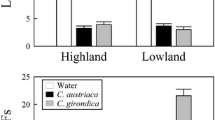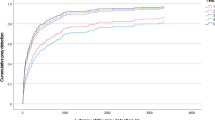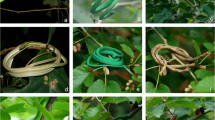Abstract
The ability of hatchling pine snakes (Pituophis melanoleucus) to select and follow or avoid chemical odors of prey (mice,Mus musculus) on a shavings and paper substrate was investigated in Y-maze experiments, as a function of incubation temperature and experience. Incubation temperature affected behavior in the maze, and the maze choices of naive snakes, but not of snakes that had already eaten a mouse. The data indicate that snakes that have eaten, preferentially enter the arm bearing chemical stimuli from mice, whereas those that have not eaten show no preference.
Similar content being viewed by others
References
Brown, W.S., andMaclean, F.M. 1983. Conspecific scent-trailing by newborn timber rattlesnakes,Crotalus horridus.J. Herpetol. 39:430–436.
Burger, J. 1989a. Following of conspecific and avoidance of predator chemical cues by pine snakes (Pituophis melanoleucus).J. Chem. Ecol. 15:799–806.
Burger, J. 1989b. Incubation temperature has long-term effects on behavior of young pine snakes (Pituophis melanoleucus).Behav. Ecol. Sociobiol. 24:201–207.
Burger, J. 1990. Effects of incubation temperature on behavior of young black racers (Coluber constrictor) and king snakes (Lampropeltis getulus).J. Herpetol. 24:158–163.
Burger, J., andZappalorti, R.T. 1986. Nest site selection by pine snakes,Pituophis melanoleucus, in the New Jersey Pine Barrens.Copeia 1986:116–121.
Burger, J., andZappalorti, R.T. 1988. Effects of incubation temperature on sex ratios in pine snakes: Differential vulnerabilities of males and females.Am. Nat. 132:492–585.
Burger, J., Zappalorti, R.T., andGochfeld, M. 1987. Developmental effects of incubation temperature on hatchling pine snakesPituophis melanoleucus.Comp. Biochem. Physiol. 87A:727–732.
Burger, J., Zappalorti, R.T., Gochfeld, M., Boarman, W.I., Caffrey, M., Doig, V., Garber, S.D., Lauro, B., Mikovsky, M., Safina, C., andSaliva, J. 1988. Hibernacula and summer den sites of pine snakesPituophis melanoleucus in the New Jersey Pine Barrens.J. Herpetol. 22:425–433.
Burghardt, G.M. 1973. Chemical release of prey attack: Extension to naive newly hatched lizards,Eumeces fasciatus.Copeia 1973:178–181.
Burghardt, G.M. 1980. Behavioral and stimulus correlates of vomeronasal functioning in reptiles: Feeding, grouping, sex, and tongue use, pp. 275–301, D. Muller-Schwarze, and R.M. Silverstein (eds.).in Chemical Signals in Vertebrates and Aquatic Invertebrates. Plenum Press, New York.
Charnier, M. 1966. Action de la temperature sur la sex-ratio chez l'embryond'Agama agama (Agamidae, Lacertilien).Soc. Biol. Quest Afr. 160:620–622.
Chiszar, D., Radcliff, C., Boyd, R., Radcliff, A., Yun, H., Smith, H.M., Boyer, R., Atkins, B., andFeiler, F. 1986. Trailing behavior in cottonmouths (Agkistrodon piscivorus).J. Herpetol. 20:269–272.
Cooper, W.E. 1989. Strike-induced chernosensory searching occurs in lizards.J. Chem. Ecol. 15:1311–1320.
Cooper, W.E., 1991. Chemical detection of predators by a lizard, the broad-headed skink (Eumeces laticeps). J. Exp. Zool. In press.
Cooper, W.E., andAlberts, A.C. 1990. Responses to chemical food stimuli by an herbivorous actively foraging lizard,Dipsosaurus dorsalis.J. Herpetol. 46:259–266.
Cooper, W.E., andVitt, L.J. 1984. Detection of conspecific odors by the female broad-headed skink,Eumeces laticeps.J. Exp. Zool. 229:49–54.
Cooper, W.E., andVitt, L.J. 1985. Responses of the skinks,Eumeces fasciatus andE. laticeps, to airborne conspecific odors: Further appraisal.J. Herpetol. 19:481–486.
Cooper, W.E., andVitt, L.J. 1986a. Tracking of female conspecific odor trails by male broadheaded skinks (Eumeces laticeps).Ethology 71:242–248.
Cooper, W.E., andVitt, L.J. 1986b. Interspecific odor discrimination by a lizard (Eumeces laticeps).Anim. Behav. 34:367–376.
Cooper, W.E., andVitt, L.J. 1986c. Interspecific odor discrimination among syntopic congeners in scincid lizards (genusEumeces).Behavior 97:1–9.
Cooper, W.E., andVitt, L.J. 1986d. Thermal dependence of tongue-flicking and comments on use of tongue flicking as an index of squamate behavior.Ethology 71:177–186.
Cooper, W.E., Garstka, W.R., andVitt, L.J. 1986. Female sex pheromone in the lizardEumeces laticeps.J. Herpetol. 42:361–366.
Deeming, D.C., andFerguson, M.W.J. 1989a. Effect of incubation temperature on growth and development of embryos ofAlligator mississippiensis.J. Comp. Physiol. B. 159:183–193.
Deeming, D.C., andFerguson, M.W.J. 1989b. The mechanism of temperature dependent sex determination in Crocodilians: A hypothesis.Am. Zool. 29:347–383.
Ferguson, M.W.J., andJoanen, T. 1982. Temperature of egg incubation determines sex inAlligator mississippiensis.Nature 296:850–853.
Fitch, H.S. 1963. Criteria for determining sex and breeding maturity in snakes.Herpetologia 16:49–51.
Ford, N.B. 1982. Species specificity of sex pheromone trails of sympatric and allopatric garter snakes (Thamnophis).Copeia 1982:10–13.
Ford, N.B., andO'Bleness, M.L. 1986. Species and sexual specificity of pheromone trails of the garter snake,Thamnophis marcianus.J. Herpetol. 20:259–262.
Ford, N.B., andSchofield, C.W. 1984. Species specificity of sex pheromone trails in the plains garter snake,Thamnophis radix.Herpetologica 40:51–55.
Gehlback, F.R., Watkins, J., andKroll, J. 1971. Pheromone trail following studies of typhlopid, leptotyphlopid, and colubrid snakes.Behavior 40:282–294.
Gregory, P.T. 1983. Identification of sex of small snakes in the field.Herpetol. Rev. 14:42–43.
Gutzke, W.H.N., andCrews, D. 1988. Embryonic temperature determines adult sexuality in a reptile.Nature 332:832–834.
Gutzke, W.N., Paukstis, G.L., andMcDaniel, L.C. 1985. Skewed sex ratios of aduit and hatchling bull snakes,Pituophis melanoleucus, in Nebraska.Copeia 1985:649–652.
Heller, S., andHalpern, M. 1981. Laboratory observations on conspecific and congeneric scent trailing in garter snakes (Thamnophis).Behav. Neurol. Biol. 33:372–377.
Krekorian, C.O. 1989. Field and laboratory observations on chemoreception in the desert iguana,Dipsosaurus dorsalis.J. Herpetol. 23:267–273.
Lang, J. 1987. Crocodilian thermal selection, pp. 301–307,in G.J.W. Webbs, S.C. Manolis, and P.J. Whitehead (eds.). Wildlife Management: Crocodiles and Alligators. Surry, Baetty and Sons, London.
Lang, J.W., Andrews, H., andWhitaker, R. 1989. Sex determination and sex ratios inCrocodylus palustris.Am. Zool. 29:935–952.
Mason, R. 1991. Reptilian pheromones,in C. Gans and D. Crews (eds.). Biology of the Reptilia, Vol. 18. Academic Press, New York. In press.
Vinegar, A. 1974. Evolutionary implication of temperature induced anomaly of development in snake embryos.Herpetologica 30:73–74.
Von Achen, P.H., andRakestraw, J.L. 1984. The role of chemoreception in the prey selection of neonate reptiles,in Vertebrate Ecology and Systematics-A Tribute to Harry S. Fitch. R.A. Seigel, L.E. Hunt, J.L. Knight, L. Malaret, and N.L. Zuschlag (eds.). Museum of Natural History, University of Kansas, Lawrence, Kansas.
Webb, G.J.W., andCooper-Preston, H. 1989. Effects of incubation temperature on crocodiles and the evolution of reptilian oviparity.Am. Zool. 29:953–971.
Weldon, P.J. 1982. Responses to ophiophagous snakes by snakes of the genusThamnophis.Copeia 1982:788–794.
Weldon, P.J., andBurghardt, G.M. 1979. The ophiophage defensive response in crotaline snakes: Extension to new taxa.J. Chem. Ecol. 5:141–151.
Yntema, C.L. 1976. Effects of incubation temperature on sexual differentiation in the turtleChelydra serpentina.J. Morphol. 150:453–462.
Yntema, C.L. 1979. Temperature levels and periods of sex determination during incubation of eggs ofChelydra serpentina.J. Morphol. 159:17–27.
Author information
Authors and Affiliations
Rights and permissions
About this article
Cite this article
Burger, J. Response to prey chemical cues by hatchling pine snakes (Pituophis melanoleucus): Effects of incubation temperature and experience. J Chem Ecol 17, 1069–1078 (1991). https://doi.org/10.1007/BF01402934
Received:
Accepted:
Issue Date:
DOI: https://doi.org/10.1007/BF01402934




